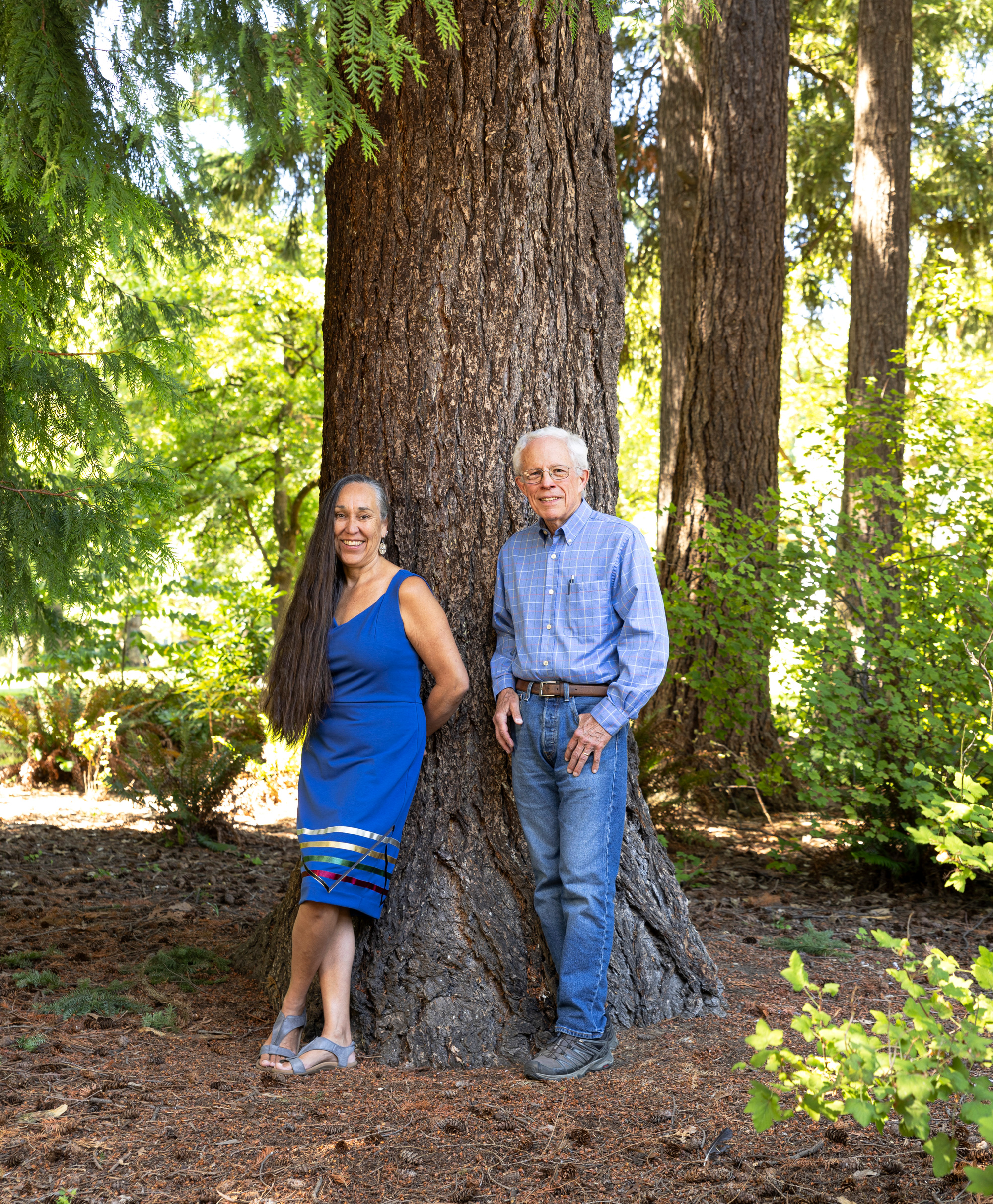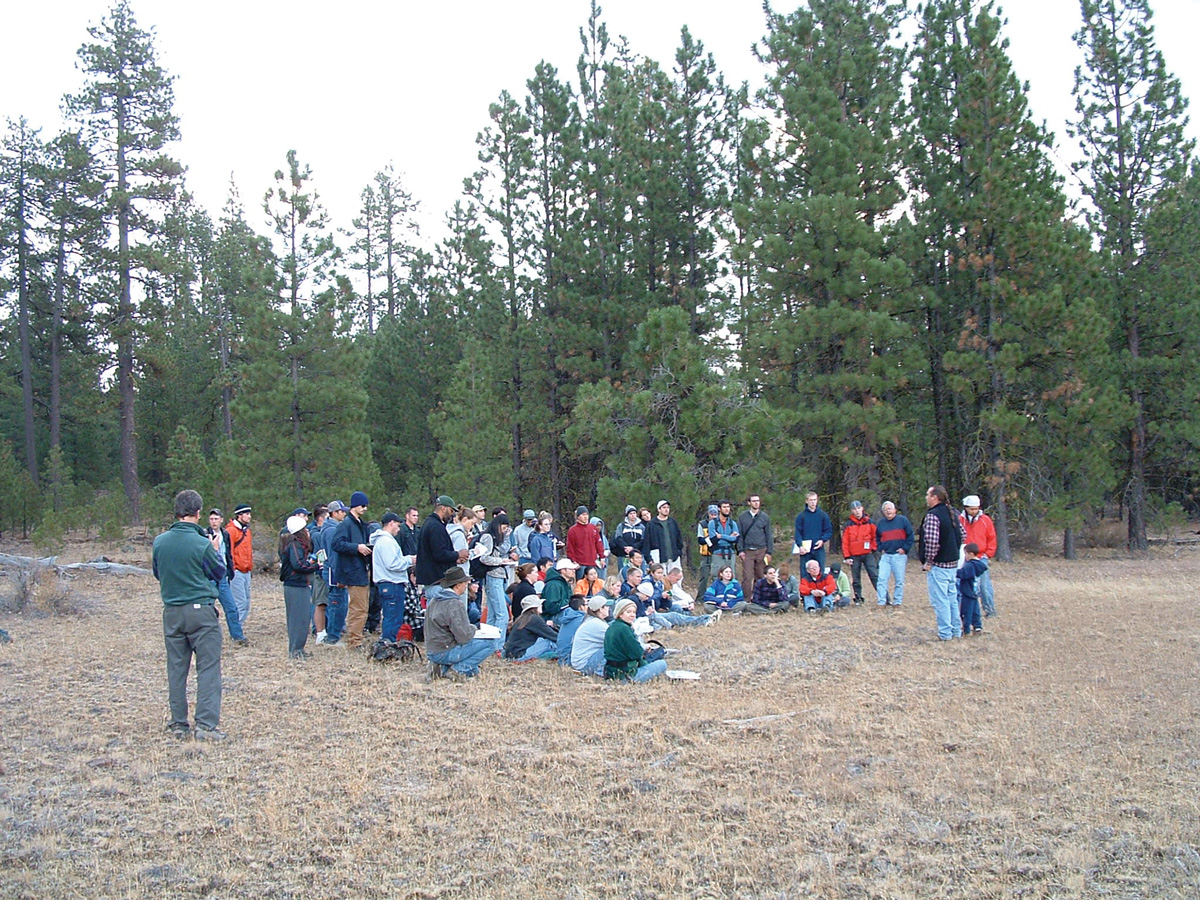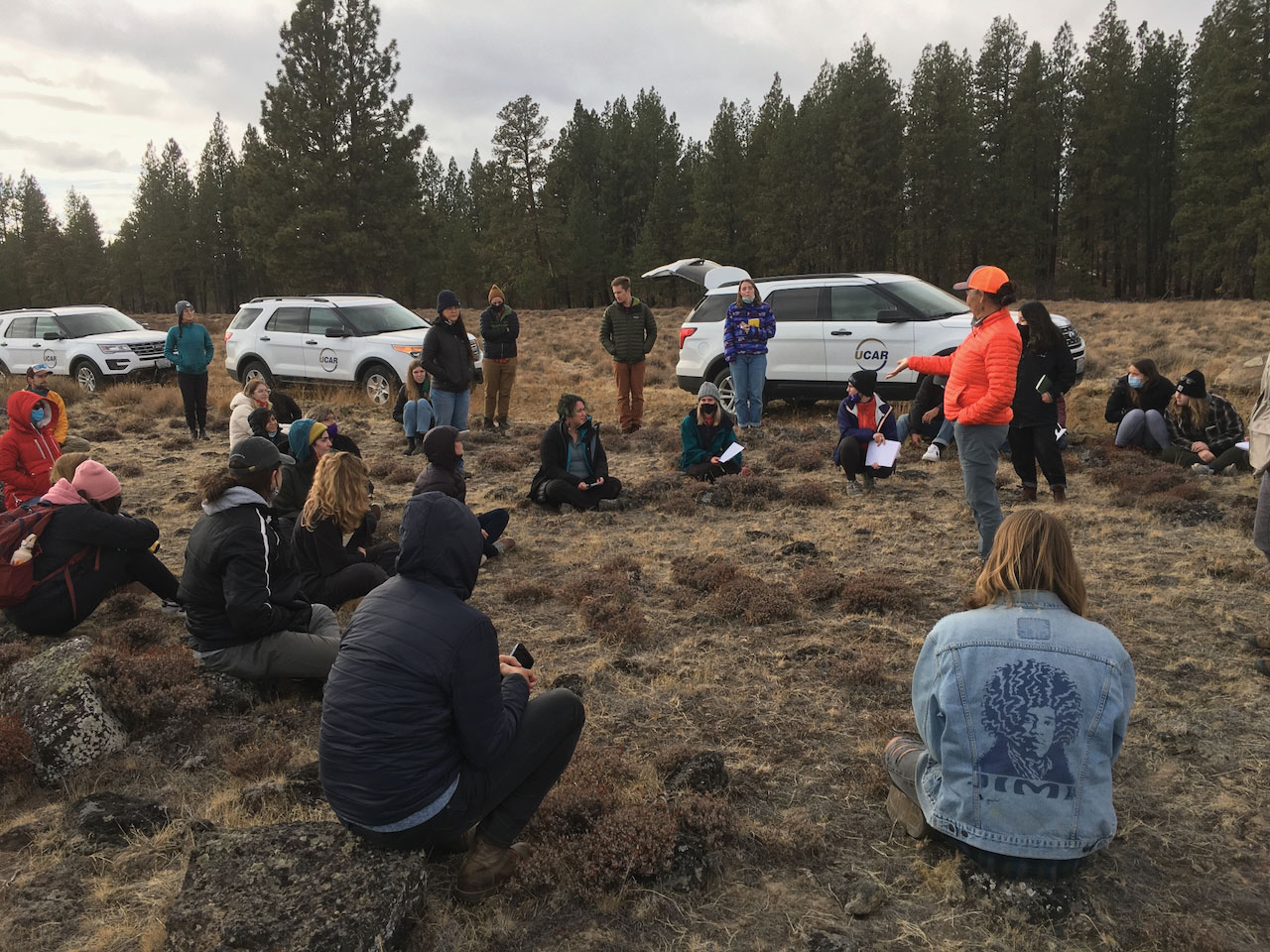Tribe and Timber Tribe and Timber Tribe and Timber
With help from the Yakama Nation, Tom Hinckley learned to see the forest for the trees
By Caitlin Klask | Photo by Ron Wurzer | September 2023

Above: Polly (Rigdon) Olsen, ’94, and other Yakama tribal members helped teach Tom Hinckley, ’71, to broaden his understanding of natural resource leadership.
Anyone who keeps up with their grade-school science lessons knows that a forest ecosystem is a complex balance between living organisms and their environment. When we alter that balance, whether through harvesting timber or camping in the backcountry, we may (or, more often, may not) feel a responsibility to cover our footsteps—to leave no trace, to plant a tree for every tree harvested—so that the ecosystem continues.
But what if we considered ourselves as an integral part of that ecosystem? What if our culture, our families, and our economy connected us more intimately and personally with the land we occupy?
The Yakama Nation reservation consists of 1.6 million acres in south central Washington state. Approximately two-thirds of these acres are forested, and three UW School of Environmental and Forest Sciences (SEFS) alumni hold deep passions for that land: Phil Rigdon, ’96, deputy director of natural resources for the Yakama Nation; Everett Isaac, ’96, ’99, Yakama Nation assistant superintendent of natural resources; and Steve Rigdon, ’02, general manager of Yakama Forest Products. When they invited faculty at the UW—including Professor Emeritus Tom Hinckley, ’71—to learn about their forests and their approach to its stewardship, Hinckley and others eagerly accepted their invitation.
In early October 2003, 62 UW undergraduate students and four faculty visited the Yakama Nation for two days, hosted by Yakama elder Arlen Washines and other tribal members, to share stories and cultural practices. This October will be the 21st consecutive visit.
“They had an approach that was strongly based on tradition but was also a merging of modern technological tools and traditional knowledge,” says Hinckley. “It was this braiding of two ways of knowing about a forest, a forest that has been part of their history since time immemorial, to which they felt our students should be exposed. As a student, you need to know that there are other ways of knowing and practices associated with landscapes and places.”
- The initial field trip to the Yakama Nation took place in 2003. Tom Hinckley’s 20-year collaboration with the Yakama Nation was initiated by tribal members in 2002 to demonstrate forest land stewardship using tribal knowledge, place-based cultural values, global market knowledge and 21st century technology.
- Students visit the Yakama Nation for the 19th time in 2021. During their visits, students meet tribal members who are actively integrating western science with traditional knowledge for the benefit of the tribe and its resources.
Hinckley and the Rigdons initiated a formal partnership between the SEFS and the Yakama Nation that included many shared responsibilities, of which the tribal-hosted field trip to the Yakama reservation was central. On the field trip, students and faculty heard and witnessed how tribal members embody cultural, social, ecological and economic values for the purpose of sustaining their people and their land. The visitors witnessed the harvesting and preparation of culturally significant plants for meals and food ceremonies. Similarly, they saw the full spectrum of forest stewardship, including the use of prescribed fire and the transformation of a log into lumber. “Most students at the UW don’t have these kinds of experiences when you go and talk to Weyerhaeuser or the U.S. Forest Service about a forest,” says Hinckley.
The class, titled “Role of Culture and Place in Natural Resource Stewardship: The Yakama Nation Experience,” touches on environmental and social injustices, like federal laws that conflict with cultural practices, or the prioritization of saving second homes versus saving reservation forests during wildfires. “When part of the Department of Natural Resources state-managed land burns, they have other lands in other parts of the state that they can use to extract wood to meet trust obligations,” says Hinckley. “Whereas with tribal lands, that’s their only land, which is a very small part of their original homeland.”
More than 800 students have visited the Yakama Nation lands as part of these UW field trips. For the past decade, Hinckley—who retired in 2012—has sustained the course as an unpaid volunteer. The reins are now in the hands of former co-instructors Ernesto Alvarado, a SEFS faculty member and fire ecologist from Mexico, and Polly (Rigdon) Olsen, ’94. Olsen has assumed a critical instructional role over the last three years, including guiding students and tribal participants.
Olsen, who came to the UW in the late ’80s, followed by her brothers—Phil and Steve Rigdon—took the course to the next level. “We’ll keep the basic framework,” she told Hinckley, “but I’m going to add some other voices to it.”
Hinckley speaks passionately about Olsen’s changes to the class. “You hear from a very broad cross-section of the tribal leadership and elders involved in all sorts of social and environmental and health-related issues with the Tribe, integrating that into our understanding of how Native people think about their culture and their homeland—where they’ve been, where they are and where they’re going.”
“It gets back to the saying that you have two eyes, two ears and one mouth, and you strive to use them in that proportion.”
Tom Hinckley
Before the three siblings invited Hinckley to think differently about teaching forestry, he taught from his own perspective, that of a white researcher from Pennsylvania who loved the outdoors. “My brothers just called him in,” says Olsen. “They said, ‘You’re talking about traditional knowledge, and you’re not talking to the people who know the most about it.’” She tells a story of Hinckley on the first field trip: He arrived on Yakama Nation lands, hopped out of the bus and immediately began teaching—both to his own students and the Yakama people. “He starts telling Yakama people and guests the importance of this land, and he caught himself! Because everybody was looking at him, especially the Natives. So, with that, he started his own journey of looking at whose voices are being heard, whose stories are being told.
“He’s always listened to the trees and the forests and the plants, but he started listening differently,” says Olsen.
Olsen and her brothers admit it was a risk to bring Hinckley and his field-trip participants to their ancestral lands. But all three of them agree on one thing: He kept showing up. “Tom just stayed in the journey, and he didn’t get distracted,” says Olsen.
“It gets back to the saying that you have two eyes, two ears and one mouth, and you strive to use them in that proportion. Because you listen and because you witness, you become much more sensitive,” says Hinckley. “Being persistent. Showing up. Being the consistent face that people saw.” Hinckley showed up by sponsoring a campus gathering for a relative, and a UW student, who died in a car accident. He showed up by prioritizing the recruitment of Native students to the UW. He showed up by creating a support fund for students who need money to support their lives and learning at the UW, enabling them to honor the deep familial ties in Native and BIPOC families.
“The important part is the scholars that we touch and impact,” says Olsen, adding that “education is always going to be worth it. The hope for the future is that more instructors will teach as Tom has learned—to value other innovations, other contributions, to give credit where credit is due.”
When he taught forestry during his 43-year career at the UW from his own perspective, Hinckley didn’t see the forest for the trees. By listening to the original stewards of the land, adding their voices to the course and eventually handing over the reins, he became a true part of the forest ecosystem.
For his work with the Yakama Nation, Tom Hinckley received the Golden Graduate Distinguished Alumnus Award for sustained, long-term and meaningful engagement with the UW. With the help of Polly Olsen, ’94, left, and other Yakama members, he taught his students to broaden their understanding of natural resource stewardship.

